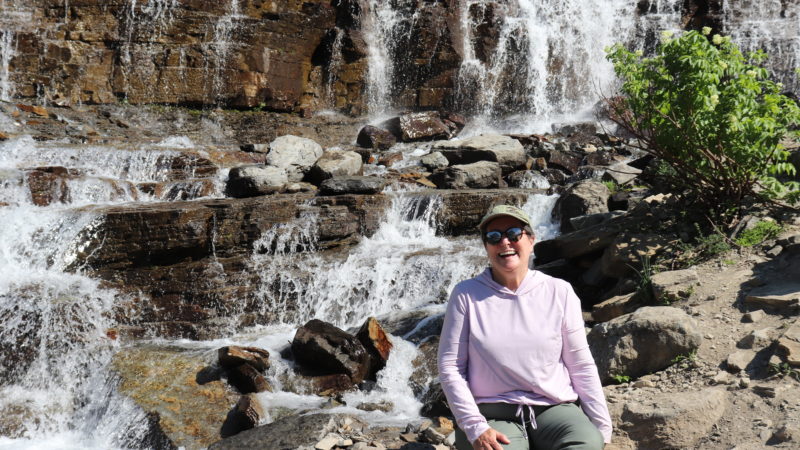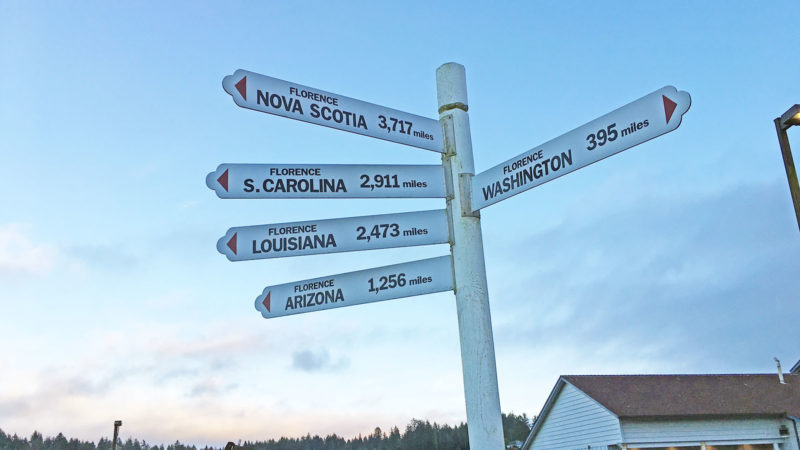A Different World?
April, 2024
It certainly felt like a different world. Maybe even a different time? Big Bend National Park in Texas is a long way away from just about everything other than Mexico. There are no walls or fences in the park between the U.S. and Mexico. Only the Rio Grande River separates the two countries and the river is easy to wade across in some parts. We camped at the park’s Rio Grande River Village Campground, so we were just a few minutes’ walk from Mexico.
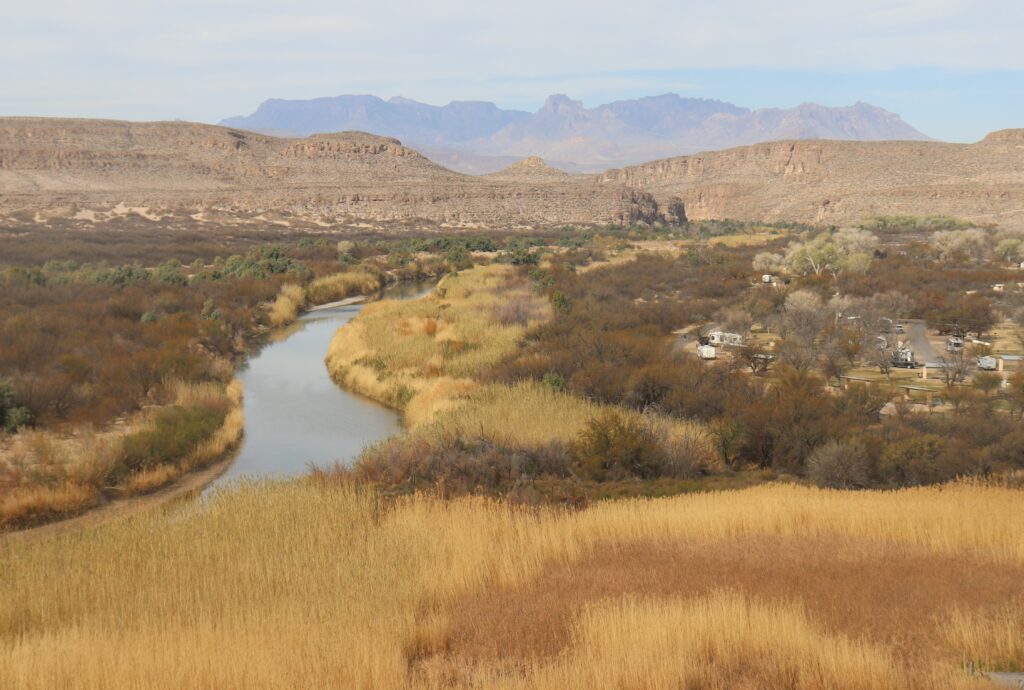
Soon after we arrived, we visited with the campground hosts. Camp hosts are usually couples who live in a campground for a few weeks or months at a time. They are there to help campers as well as perform various jobs around the campground. We asked them about area food options. When camping out, we always have enough food to last at least one week. But it is good to know what eating alternatives are nearby. There was a small, essentials-type grocery in the campground. The only restaurant in the park was about 30 miles away. The hosts told us that they occasionally go into Mexico to a little town of Boquillas del Carmen (Boquillas) for lunch. That kind of startled us. A trip to Mexico sounded like a lot of effort just for a quick lunch. The border crossing alone could be time consuming.
Or so we assumed. Truth be told, one of us (Bob) had never been to Mexico. The other one of us (Julia) had been to Mexico once – when she was in college.

The hosts told us which of the town’s two restaurants to go to and, if we did, to make sure we ordered the goat tacos. It sounded intriguing but all that effort for a goat taco? The two of us discussed it over the next few days between hikes and driving excursions. Our last day in the park was soon upon us and we decided to go. If we had not made the journey, we probably would have just hung out in our campervan all day. The wind was fierce, blowing sand through the campground at speeds upwards of 30 mph.
The port of entry into Mexico was a 10-minute drive from our campground. It was a small, well-maintained building with a decent-sized crowd of people inside. U.S. citizens and Mexicans alike were getting processed coming and going. Only one border patrol officer was present to handle the flow, but he had help from other officers on a video phone, interviewing people coming into the states. After looking at our passports, asking us a few questions and giving us obligatory warnings, he sent about 10 of us on our way out the door. His last warning was that we needed to be back inside the building by 4 pm sharp as that is when the doors lock. We would need to recross into Mexico and find a place to spend the night if we were even one minute late. In reality, it appeared we could have come back into the states after 4 pm, but our van would have been stuck in the parking lot behind a locked gate until the next morning.
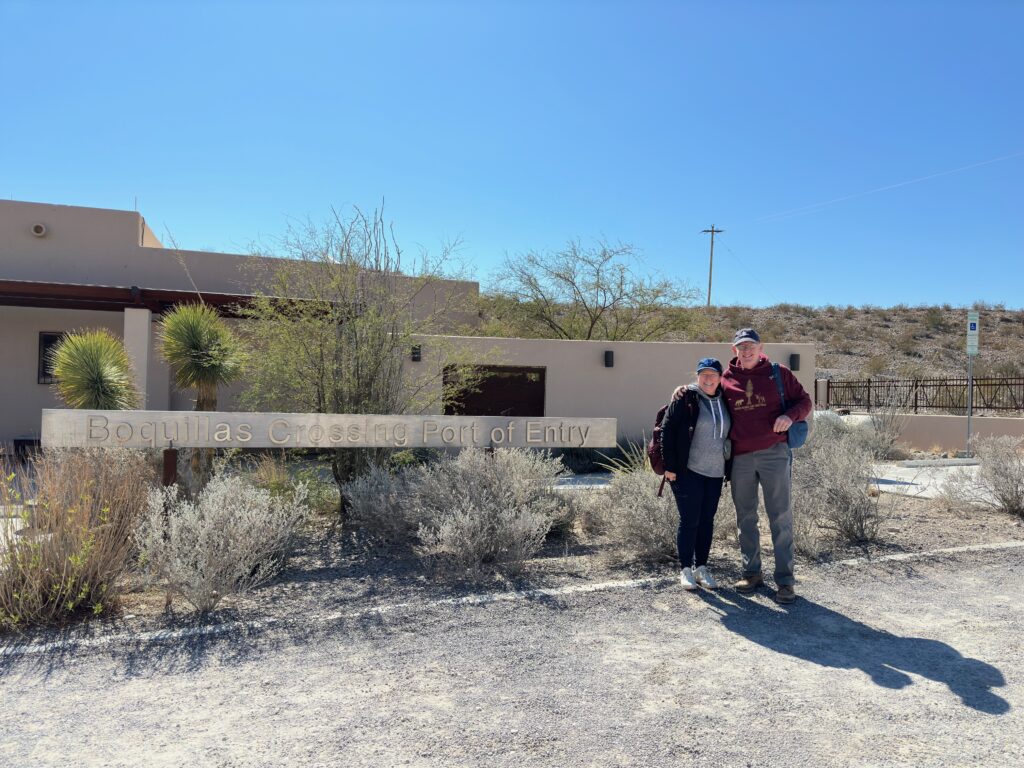
We then left the office through the door that leads to Mexico. This is when we felt like we entered another world or time. We casually walked down a sandy path through some trees to arrive at the river’s edge. There were no fences or walls, just a young Mexican man standing on the U.S. side with a little rowboat in the water beside him. We climbed in and he then waded across the river, pulling the boat behind him. We could have walked across the river too if we had wanted, our choice. The rowboat cost $10 per person, U.S. dollars of course. We think everyone in our group climbed in the rowboat for the 30-second water crossing.
Besides no barrier, there was no outward evidence we were standing at a border crossing – other than a man patiently waiting with his well-worn rowboat. The park service, along with the border patrol, permits this old-school movement of people from one side to the other. In fact, they encourage it. The park’s brochure makes sure visitors know just such a trip into Mexico is readily available and provides the pricing so visitors know to bring cash. As if to reinforce this point, the port of entry facility is named Boquillas Crossing
We said “just a man” brought us to the shores of Mexico but there was actually a fairly large crew of men and women (and children) on the Mexican side ready to handle the tourist traffic. It was quite the extensive operation. If one didn’t know it before crossing the Rio Grande, it would soon became apparent that Boquillas is a tourist town.
Once we climbed out of the boat, we had our choice of how to get into town, which was a ½ mile away. We could walk. Or we could pay to be chauffeured in one of the crew’s vehicles. Or we could ride a horse. Or we could ride a burro. Absent the wind, walking would have been our preferred mode of transportation.
So… naturally we chose the burro mode. After all, on such an excursion, one should get the full experience, right? The sign directing us towards town may have said ½ mile but we can assure you, sitting on the back of an old burro in a too-loose saddle made it seem a lot longer. Plus, the blowing sand made it hard to see clearly at times.
Sand or no sand in our eyes, one thing we didn’t see were any Mexican border authorities at the border. We did see a Mexican police truck drive by as we were doing our best to stay on our burros. But he seem unconcerned with us.
One of the men working at the river escorted us into town. He walked while we rode. He stayed by Julia’s burro, periodically tapping its backside and talking to it in Spanish to encourage it to keep moving in the right direction. After we dismounted, with great relief, he led us to an official looking building on the edge of town. Apparently it was a Mexican port of entry, yet the only thing the young lady inside wanted was $4/person to help fund the conservation district Boquillas resides in.
Our escort then led us directly to one of the town’s restaurants – the one that did not serve the goat tacos. We thanked him and proceeded to walk across the street to the one with the goat tacos. And just in case you are wondering, Julia says her goat taco lunch was one of the best Mexican meals she has ever had. Bob sampled them as well and agrees they were very good. As a bonus, the owner was a joy to talk to. The restaurant was sparsely populated, however. We subsequently went back across the street to the first restaurant to sample its sopapillas, which were also very good. It soon became clear there was, at the very least, a handshake agreement between the river transport venture and this restaurant. The place was packed with tourists. Our burro whisperer / escort was there too – waiting tables.
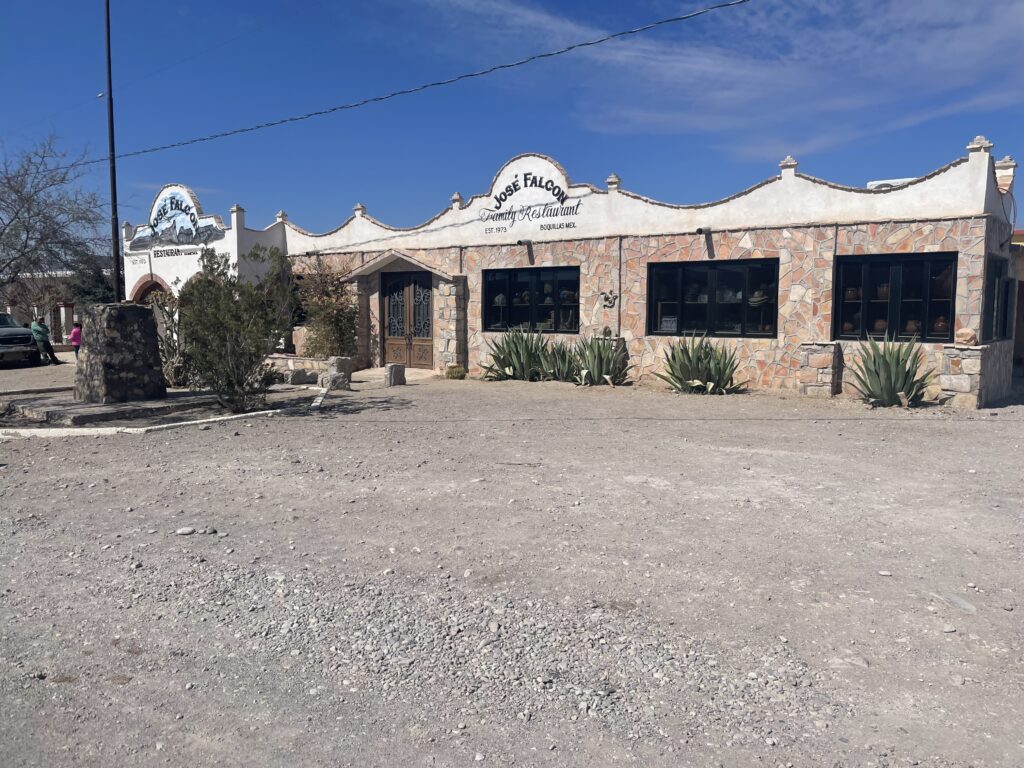
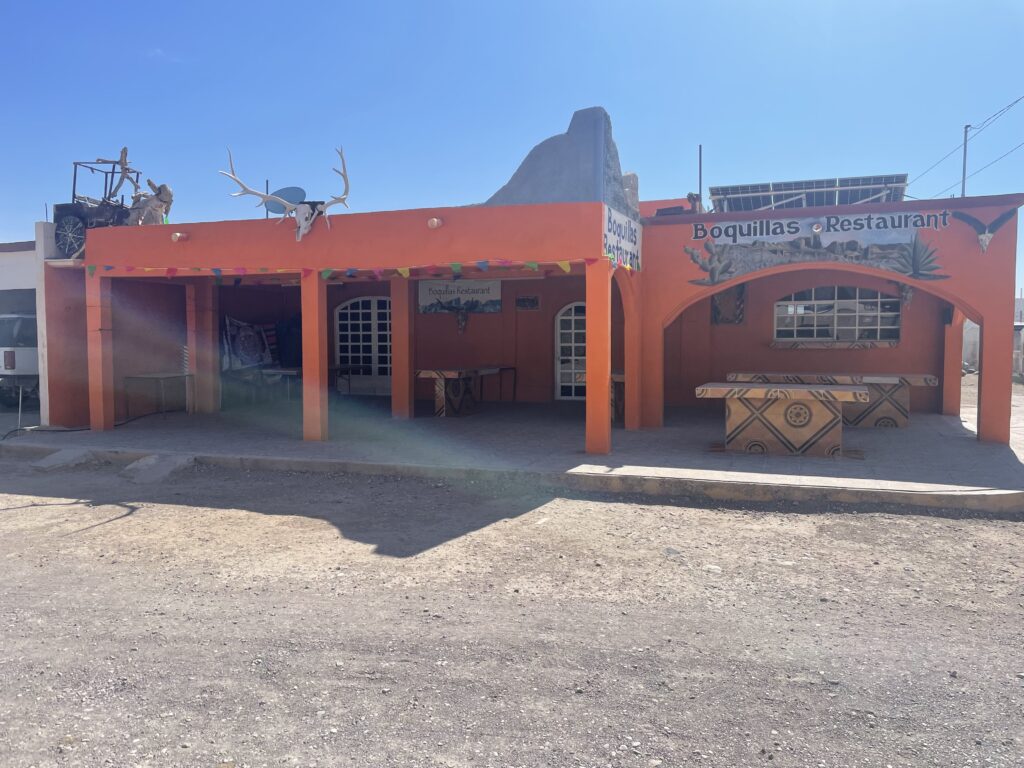
As we finished eating and were ready to head back to the U.S., our escort showed up by our side to… well, escort us back to the river crossing. We let him drive us in his pick-up truck, which was parked nearby. It was an extra fee but we opted to not take the bumpy old burros back to the border. The wind was still howling so we decided not to walk either. Better to support the local economy one last time. While his truck cab was definitely superior to the wobbly saddles, the truck looked like it was slowly becoming part of the sandy desert, inside and out. We had a nice conversation with him though, something we were unable to manage while riding the burros.
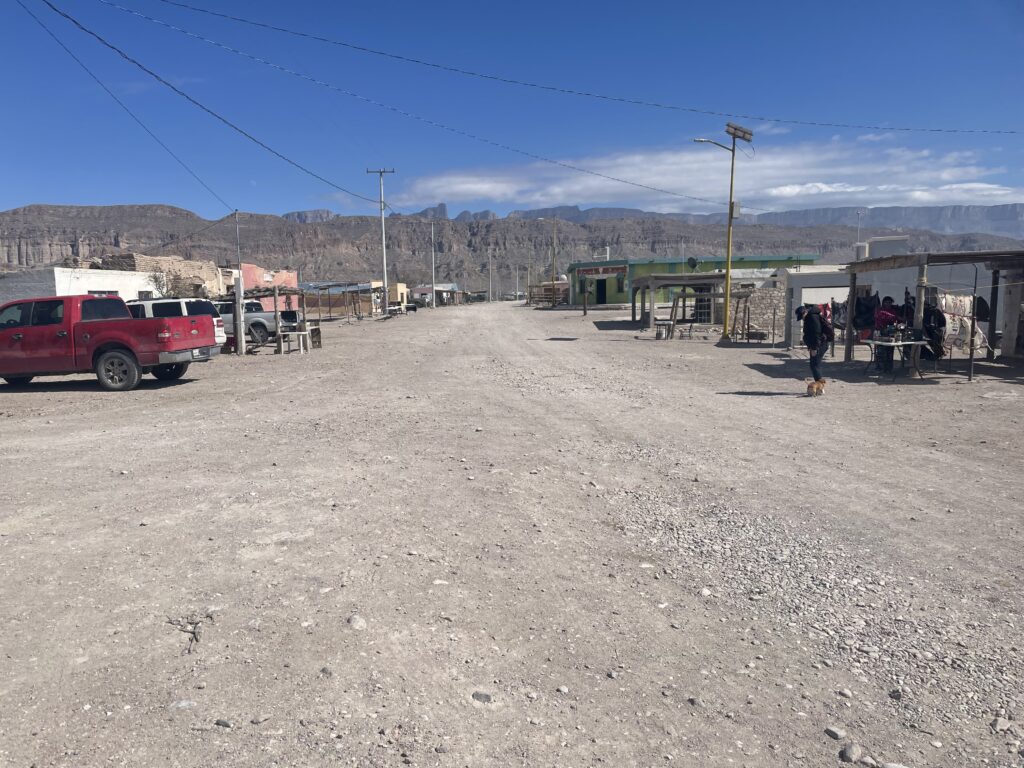
With essentially no previous border experience, our entire day seemed to be a long ways from everything we read and see in the news about the chaotic U.S. – Mexican border situation. Our outing was a very casual, calm, and friendly affair. We could have taken the rowboat back and forth repeatedly without anyone stopping us – or maybe even caring. Indeed, the Mexican man pulling boatloads of tourists through the water was doing just that. We didn’t see anything preventing people from sneaking across from either side.
We know for a fact that Mexicans were traversing back and forth across the border at various spots in the park unimpeded. We came across several locations in the park where they left pottery and various trinkets to be bought by park visitors. Since they could not stay with their goods, they left little containers for buyers to deposit their cash into. Interestingly, while we were warned it was against the law to buy any such wares on U.S. soil, it was also obvious that the park service was not confiscating this “contraband” and shutting down these unmanned markets along the roads and trails.
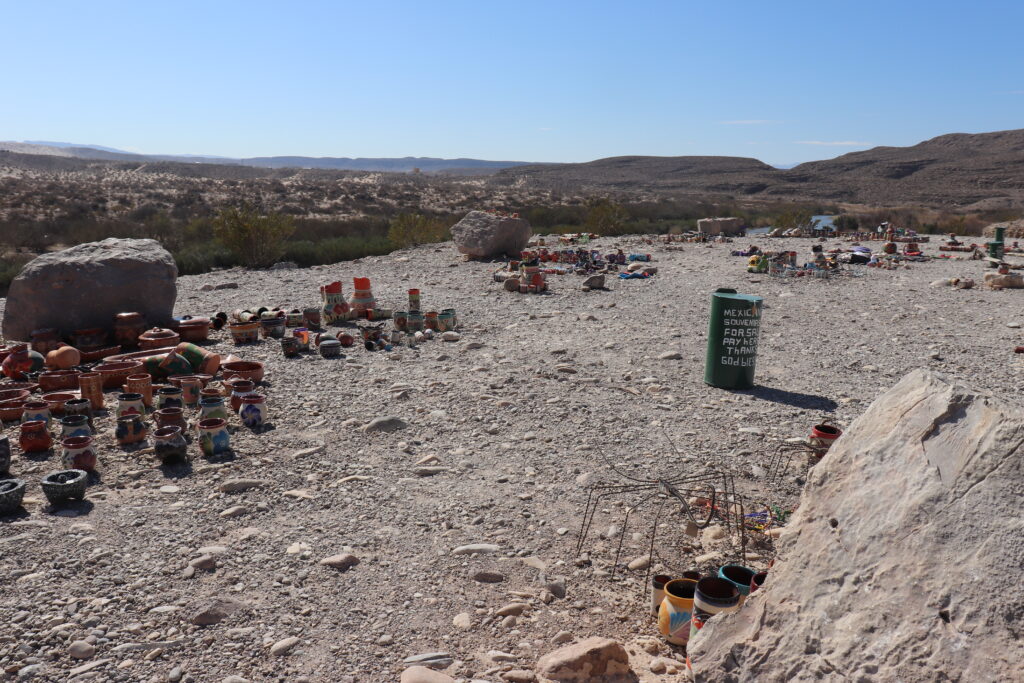
While we did not see evidence in the park of migrants heading north from the southern border, this type of traffic does exist, although less so in recent years. Steep canyon walls, a vast, unforgiving desert with few towns nearby, and border patrol cameras in the region provide significant barriers to entry. What we did experience was a land that has a long history of different cultures in a symbiotic relationship. Adaptation on both sides of the border seemed to keep desert life manageable. As if to epitomize this point, when we asked our camp hosts about the animal droppings seen in our campground, knowing they weren’t from any wild animal we are familiar with, they casually responded that the “deposits” are from Mexican cattle that wander back and forth across the Rio Grande. Cows apparently don’t comprehend or care that the river is the border. There is edible grass on both sides of the river so we guess they go where their noses take them. Their way of life goes on uninterrupted year after year.
That’s not to say that time has stood still in this desert wilderness. Modern technology is used on both sides of the border. One could argue, given the isolation, the residents (and authorities) depend on it. A simple example that was a first for us: a restaurant customer in front of us was able to pay her bill via Venmo.
Yet, after we thought about it later, we imagined our one-day excursion wouldn’t have been much different than if we had taken it 50 or more years ago. It just seemed so uncomplicated and free from the harsh border realities in less isolated locales. We felt like we weren’t crossing the same border that is covered by the daily news. And that was a good thing.
Header photo: the gate to the Boquillas Crossing Port of Entry
You Might also like
-
A Place. A Destination. Something Else?
West is such a simple word. Four letters, one syllable. And yet, it has a hard-to-define energy that dwarfs its brief length.
-
The Road Home… For Now
These days, paper-free takes on a whole new meaning, and it’s something all of us are trying to avoid.
-
These Out-of-Towners Loved New York
Julia had never been to New York City. The last time Bob had visited the city was in 2000. This current trip of 4 days maybe needed to be 4 weeks. To paraphrase George Washington as he was fleeing the British across Manhattan Island, “We’ll be back when we can stay longer.”


